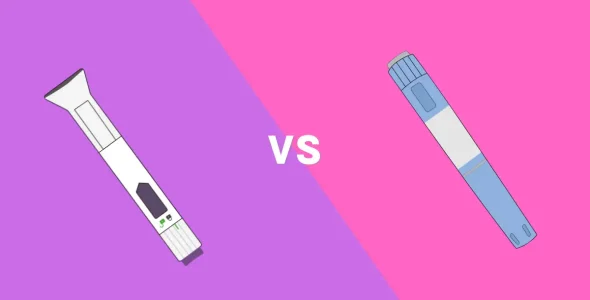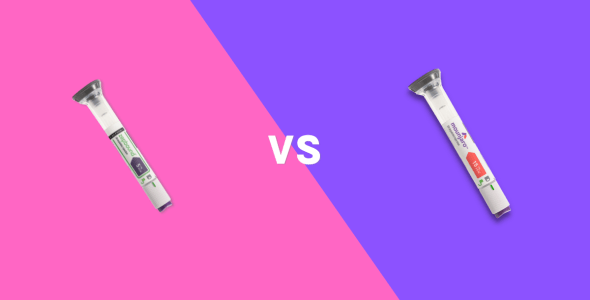Mounjaro is used as an adjunct to diet and other lifestyle changes to improve glycemic control in adults with type 2 diabetes mellitus. Saxenda can be used as a weight-loss medication.
Here we will explain how they work, their similarities and differences, their side effects, and more. This should provide you with the basics to better understand your options.
What is Mounjaro?
Mounjaro is an FDA (U.S. Food and Drug Administration) approved medication manufactured by Eli Lilly and Co. Mounjaro mimics 2 types of incretin hormones produced by the human body. It is classed as a GIP (glucose-dependent insulinotropic polypeptide) and GLP-1 (glucagon-like peptide-1) receptor agonist. GIP decreases food intake and increases energy expenditure which causes weight loss. When taken with a GLP-1 receptor agonist, it may result in greater positive effects on blood glucose and body weight.
Mounjaro is used to treat adults with type 2 diabetes mellitus. It is not for use in people with type 1 diabetes, pancreatitis, or to treat children under 18 years of age.
FDA approval for Lilly’s Mounjaro was based on the SURPASS study, which compared Mounjaro with Ozempic, insulin glargine, semaglutide 1 mg, and insulin degludec. Participants who took Mounjaro experienced an average reduction in hemoglobin A1c, HbA1c (an indicator of blood sugar level). Participants who took a placebo saw an average increase in A1C levels.
Mounjaro dosage
Mounjaro is available in injection form, in the following doses: 2.5 mg/0.5 mL, 5 mg/0.5 mL, 7.5 mg/0.5 mL, 10 mg/0.5 mL, 12.5 mg/0.5 mL, or 15 mg/0.5 mL single-dose pens.
Mounjaro is injected subcutaneously in the abdomen, thigh, or upper arm once weekly, with or without food. If you miss a dose, take the missed dose as soon as possible within 96 hours after the missed dose. If more than 4 days have passed, skip the missed dose and take your next dose on the regularly scheduled day.
Use Mounjaro alongside dietary changes and exercise to improve glycemic control and always speak with a healthcare professional about any changes to your dose so they can monitor and evaluate your condition.
What is Saxenda?
Saxenda is an FDA (U.S. Food and Drug Administration) approved medication manufactured by Novo Nordisk Inc. Saxenda contains the pharmaceutical medicine liraglutide. Liraglutide is similar to a naturally occurring hormone in the body that controls digestion, insulin levels, and blood sugar levels. Saxenda is recommended alongside a reduced-calorie diet and an increase in exercise. It is used to help manage obesity in adult patients with a body mass index (BMI) of:
- 30 kg/m2 or more, or
- 27 kg/m2 or more with a weight-related condition such as high blood pressure, type 2 diabetes, high cholesterol, triglycerides, or a low HDL cholesterol level that is making plaque build-up in your arteries worse
Saxenda is not specifically for the treatment of type 1 or type 2 diabetes or weight loss. Saxenda is part of a treatment plan that will include, diet, exercise, and weight management. GLP-1 medication is classed as a physiological regulator of appetite and calorie intake. This means it works by a method known as negative feedback. The GLP-1 receptor is seen in several areas of the brain involved in appetite regulation.
Saxenda dosage
Saxenda is available in injection form, at 6 mg/mL and delivers the following doses: 0.6 mg, 1.2 mg, 1.8 mg, 2.4 mg or 3 mg.
Liraglutide is classed as an acylated human glucagon-like peptide-1/GLP-1 receptor agonist. Liraglutide binds to and activates the GLP-1 receptor. Unlike naturally occurring GLP-1 in the body, which has a half-life of up to 2 minutes, liraglutide is stable against breakdown by enzymes in the body and has a half-life of 13 hours.
Saxenda is given as a subcutaneous injection under the skin. It can be given at any time of the day, with or without a meal. You should not inject into the same place two times in a row. If the injection has particles in it or has changed color, do not use it. Speak to your pharmacist about a new medicine. You should dispose of used needles and syringes by using puncture-proof disposal sharps containers. Store unopened pens in the refrigerator. In-use pens may be kept at room temperature for up to 30 days. Always remember to store your medicine out of the reach of children and pets.
Common side effects of Mounjaro and Saxenda
The most common side effects of Mounjaro in clinical trials include:
- Nausea, vomiting
- Gastrointestinal – diarrhea, decreased appetite, constipation, indigestion, abdominal pain
More serious side effects of Mounjaro include:
- Possible thyroid tumors, including thyroid cancer – do not use Mounjaro if you or any of your family have ever had a type of thyroid cancer called medullary thyroid carcinoma (MTC), or if you have an endocrine system condition called Multiple Endocrine Neoplasia syndrome type 2 (MEN 2)
- Inflammation of your pancreas (pancreatitis) – symptoms include severe pain in your stomach area that will not go away, with or without vomiting
- Low blood sugar (hypoglycemia) – Your risk for low blood sugar may be increased if you use Mounjaro with another diabetes medication such as a sulfonylurea or insulin
- Serious allergic reactions
- Kidney problems
- Severe stomach problems
- Changes in vision
- Gallbladder problems
The most common side effects of Saxenda in clinical trials include:
- Nausea, vomiting, and stomach pain
- Diarrhea
- Constipation
- Fast heart rate
- Tiredness
- Headaches and dizziness
More serious side effects of Saxenda include
- Increased heart rate
- Suicidal thoughts or sudden changes in behavior and mood
- Severe nausea, vomiting, or diarrhea that will not stop
- Hypoglycemia (very low blood sugar levels) – feeling very weak, shaking, confused, sweating, fainting, or seizures
- Pain or difficulty urinating, swelling in ankles or feet, tiredness, and difficulty breathing
- Trouble swallowing, lump, or swollen neck
- Jaundice – yellowing of eyes or skin, darker stools, upper stomach pain spreading to the back
- Increased risk of thyroid cancer
These aren’t all the side effects Mounjaro or Saxenda can cause. You can find more details in the patient leaflet that comes with your medication. If you have any concerns about side effects, talk to your physician or pharmacist.
Mounjaro and Saxenda drug interactions
Mounjaro can interact with other medications. These include:
- Insulin secretagogue – sulfonylurea or Insulin
- Oral medications
- Orally administered hormonal contraceptives
Saxenda can interact with other medications. These include:
- Antibiotics for bacterial infections
- Insulins – aspart, detemir, glargine, lispro
- Oral diabetes medicines
- Antiviral medication
- Diuretics
- Corticosteroids
Mounjaro and Saxenda can interact with other medications. This can change how Mounjaro and Saxenda and other medications work and can make side effects more likely. Tell your prescribing physician about all your drugs, including vitamins and dietary supplements.
Mounjaro and Saxenda contraindications
You should not use Mounjaro if you:
- Are allergic to the active ingredient tirzepatide
- Are allergic to any of the other ingredients in Mounjaro
Talk to your doctor before using Mounjaro if you:
- Are taking any of the medications that could interact with Mounjaro
- Have or have had problems with your pancreas or kidneys
- Have severe problems with your stomach
- Have a history of diabetic retinopathy
- Are pregnant or plan to become pregnant – If you take oral birth control pills by mouth, you may be recommended another type of birth control for 4 weeks after you start Mounjaro and for 4 weeks after each increase in your dose
- Are breastfeeding or planning to breastfeed. It is not known if Mounjaro passes into your breast milk
You should not use Saxenda if you:
- Are allergic to the active ingredient liraglutide
- Have had an allergic reaction to any of the other ingredients in Saxenda
- Are using insulin or albiglutide, dulaglutide, or exenatide
- Have multiple endocrine neoplasia type 2
- Have a family history of medullary thyroid carcinoma
- Have diabetic ketoacidosis
- Are under 18 years of age
Talk to your doctor before using Saxenda if you:
- Are taking any of the medications that could interact with Saxenda
- Have kidney disease
- Have liver disease
- Have high cholesterol or triglycerides
- Have heart problems
- Have problems with your pancreas or gallbladder
- Have depression or suicidal thoughts
- Have stomach or digestion problems
- Are pregnant or are planning to become pregnant
- Are breastfeeding or are planning to breastfeed
Other drugs for diabetes
If you have any concerns about Mounjaro or Saxenda side effects, talk to your physician, or pharmacist for medical advice. Also inform your healthcare provider about any medical conditions, supplements, and over-the-counter meds you are taking. You are also encouraged to report side effects to the FDA: visit http://www.fda.gov/medwatch or call 1-800-FDA-1088.








